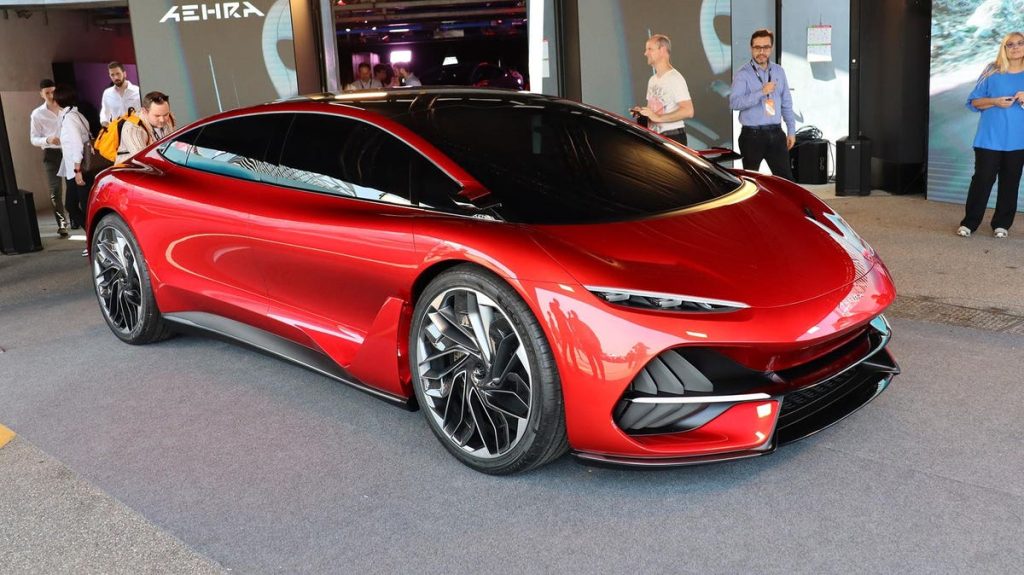Milan-based startup AEHRA has unveiled the second product in its range, a sedan. This comes after the AEHRA SUV design was revealed towards the end of 2022. The new car was presented at the Milano Monza Motor Show, an open-air event that takes place at the legendary race location. If the SUV was nothing like any SUV that went before, the sedan looks even more like a Lamborghini supercar. But with four doors and proper rear seats, it’s aimed at the same luxury space as the Tesla Model S, Lucid Air, or even the likes of Jaguar, Bentley, and Rolls Royce. Will it be able to compete? I went to Italy to investigate.
The Lamborghini similarity is no surprise when you realize that the head designer behind both AEHRA vehicles is Filippo Perini, who was involved in the inception of numerous icons from the famous Italian sportscar brand, including the Murciélago, Aventador, Urus, and Reventón. AEHRA has taken a radical approach to its vehicle design, however, which founder and CEO Hazim Nada sums up with the question, “What form should a car take when you design around being electric, instead of reworking from internal combustion?”
This has led to the unique common trait of both the SUV and the sedan, which Perini calls “no bonnet” (or “no hood” for American readers). Where a fossil fuel engine is best placed in a separate compartment in front of the passengers, for noise and safety reasons, this is not necessary for an electric car. The motors can sit in line with the axles they drive, and the batteries under the floorplan. This means you don’t need a long expanse of metal ahead of the driver, enabling the cabin to start further forward for much more interior space.
The design impact of this was evident for the SUV, but the height of this vehicle format softened the effect. With the sedan, the short nose is extremely pronounced, and is what makes the car so reminiscent of a sports-oriented supercar. The effect of this on the interior wasn’t visible at the launch because the car unveiled had deliberately darkened glass to make it impossible to see inside. But if you look at the door widths, this is no 2+2. The sloping rear roof might affect headroom, but the sedan is a proper four-seater like the Porsche Taycan – except with looks that make the latter seem decidedly last century.
The aggressive appearance is accentuated by ridiculously massive 24in wheels, which AEHRA told me will make it all the way through to production. I do wonder how they will cope with atrocious London city roads, but that’s not really the point. While the AEHRA sedan may be intended to transport four (or five?) people in comfort for long distances, it’s not likely to be a car you use for a trip to the shops – more likely the opera, or down south for a weekend in your villa on the riviera.
While the SUV, because it’s an SUV, still divided opinion with its appearance, you’d have to have a heart of pure ice not to feel moved emotionally in a very fundamental way by the looks of the AEHRA sedan. This is a pin-up quality design, with the sleek aerodynamics that Perini says he has been dreaming of since he was 14 years old. Although quite a few recent hypercars have become quite angular, the AEHRA sedan remains smooth, apart from the aggressive “mouth” at the front. AEHRA hasn’t stated the drag coefficient, but I’d be surprised if it doesn’t beat even the incredible Mercedes EQS.
So, in terms of appearance, the AEHRA sedan is gob smacking, but that’s only part of the equation for a successful new car. It needs to lead the pack “under the hood” as well, even if that hood is much shorter than normal. Nada says that the powertrain will bring together best-in-class components from third parties, although these will be optimized for the AEHRA platform. Another engineer of legendary Italian supercar background, Franco Cimatti, has recently come on board to lead this development. Cimatti most recently worked at Lotus, but before that spent 32 years at Ferrari. There, he worked on models including the 550 Maranello, 512, 612, 599 Hy-KERS, and California / FF. He was the Chief Designer behind the LaFerrari, Ferrari’s first hybrid supercar. This puts him in a good position for developing high-performance all-electric vehicles such as AEHRA’s.
Few details have been revealed about the powertrain so far. Nada says that the motor / e-axle will be revealed soon. The HVAC system has required special attention, because this is a large device and still needs a little more work to fit into the shortened space of AEHRA’s designs. AEHRA has recently announced a partnership with Miba Battery Systems, with key highlights being a 925-volt system, charging up to 350kW, and capacities up to 120kWh. The charging will be bidirectional, so that the car can be used as a home battery, although this would require a compatible home charger and energy system.
Technical details for the AEHRA Sedan are otherwise thin on the ground. AEHRA is targeting a range of 800km (500 miles), which could be achievable with a 120kWh pack. But there are no performance specifications just yet. The Sedan is based on the same platform as the SUV, which Nada explains is important to maximize the benefit of development expenditure. Although AEHRA has announced a huge “home theater” screen for its SUV, Nada says that this aspect of his company’s cars is further away, with a number of suppliers still being evaluated.
Although he didn’t want to focus on this area, Nada has also been candid that a 2+2 sportscar is in AEHRA’s future as well. Cimatti talks of a “small foot” approach to drivetrain engineering. If you have small feet, you can still wear big shoes, but not the other way around. In the car context, this means that if you design a small powertrain, it can go in small and large cars. The implication is that, although the SUV and sedan are large, the powertrain engineering inside them could fit in a smaller sports variant.
Customer deliveries of both SUV and Sedan were previously expected in 2025 but have now been pushed back to 2026. Mainstream orders will now open in 2025, although there will be a limited number of “founder’s series” slots opening in 2024. Nada still expects to hit 25,000 units a year once production ramps up. This is where the question mark over AEHRA arises. Although right now the higher-end luxury brands in the EV space are limited, by 2026 there will be a few more choices. The Rolls-Royce Spectre is due to start deliveries by the end of 2023. Jaguar expects to have its own four-door electric GT by 2025, as JLR reinvents itself as a “house of brands” with electrification at its core.
We have only the barest tease of what the electric Jaguar four-door GT will look like, but every other electric luxury vehicle so far fails to break with tradition in the way AEHRA’s SUV or sedan have. The crucial element is whether the intended high-net-worth buyer wants such a radical departure. Perini implies that the AEHRA market is likely to be younger than for other luxury brands. This question will only be answered when both cars arrive for real. But by the new sedan’s looks alone, this is a car that will make a statement. Everyone will notice when you arrive, even if the electric drivetrain will probably mean they didn’t hear you coming beforehand. For some, that could be exactly what they’re looking for in a luxury electric car.
Read the full article here










